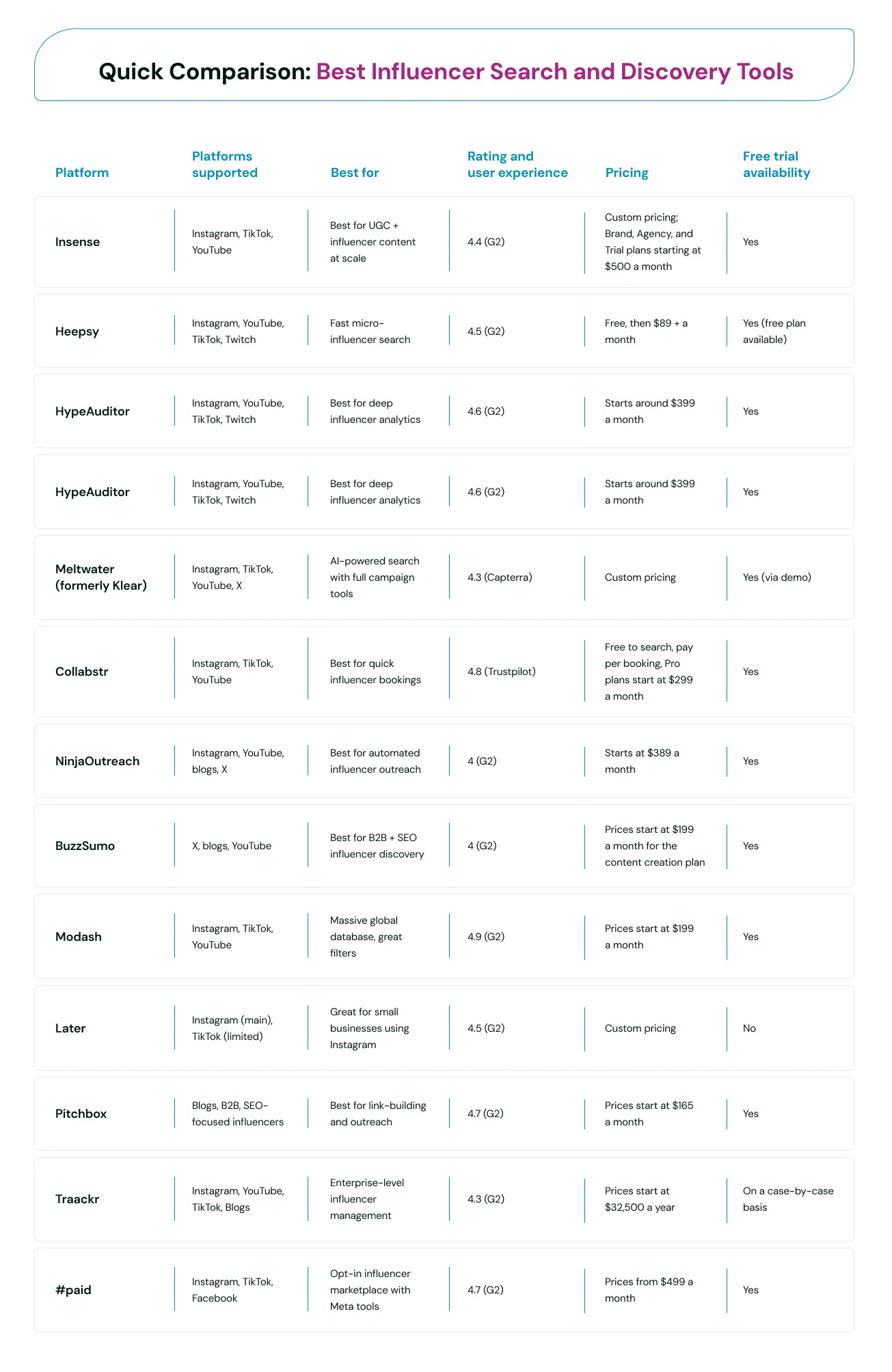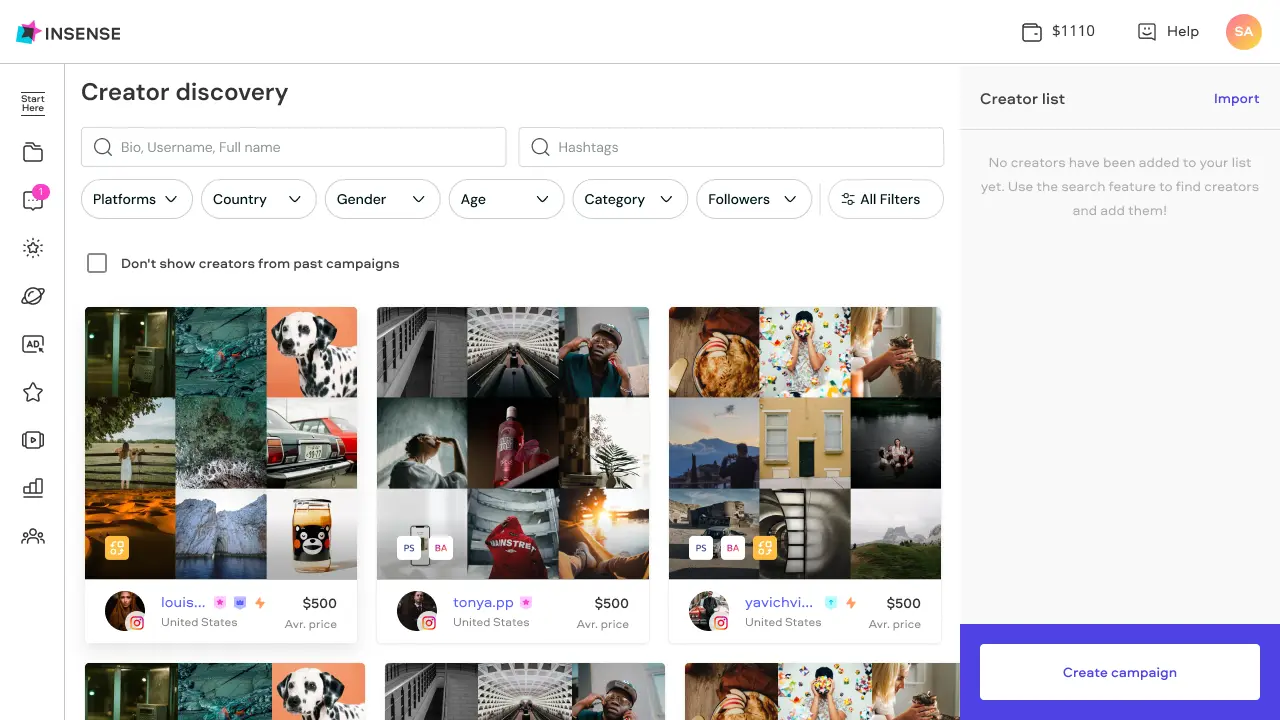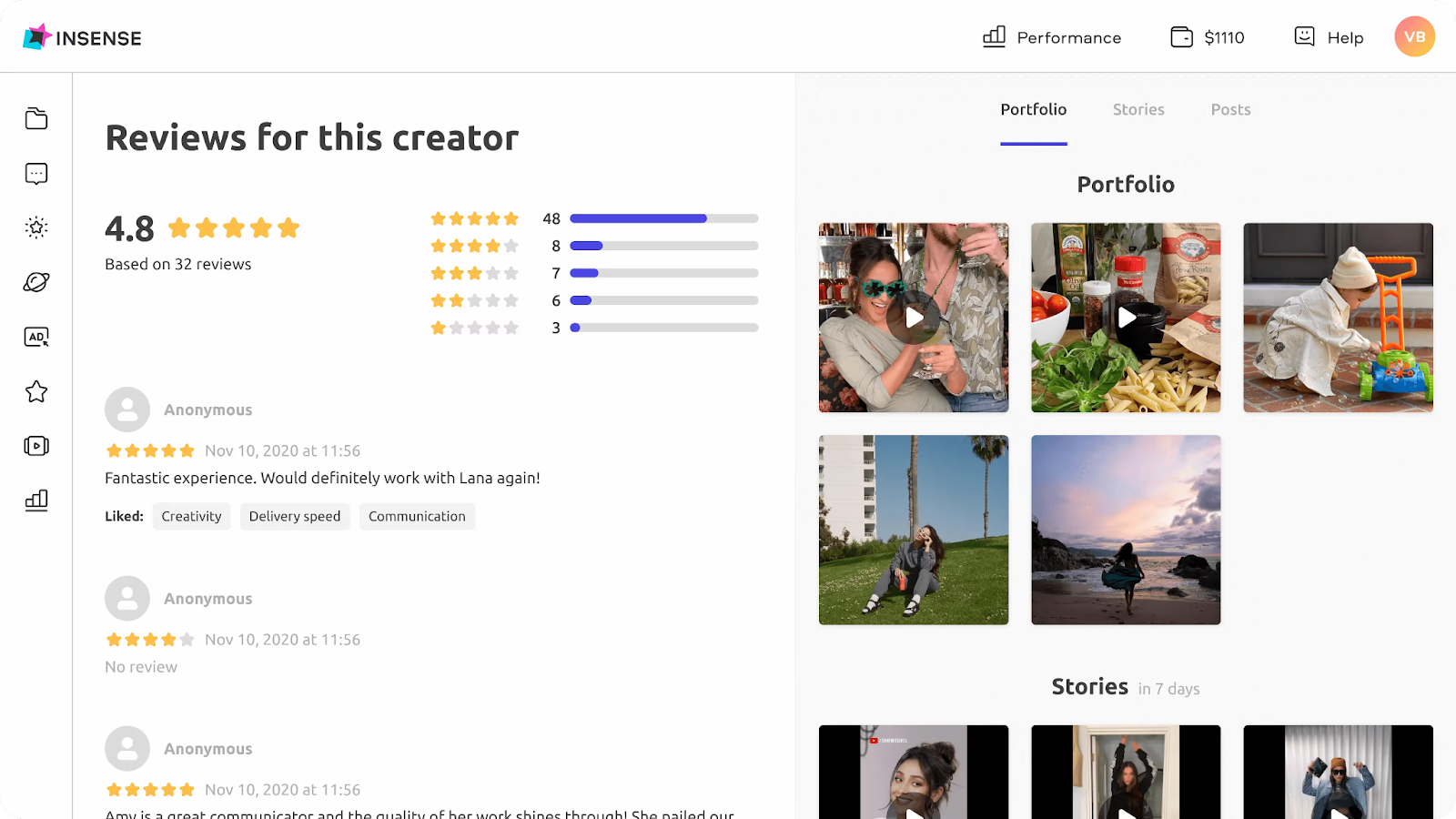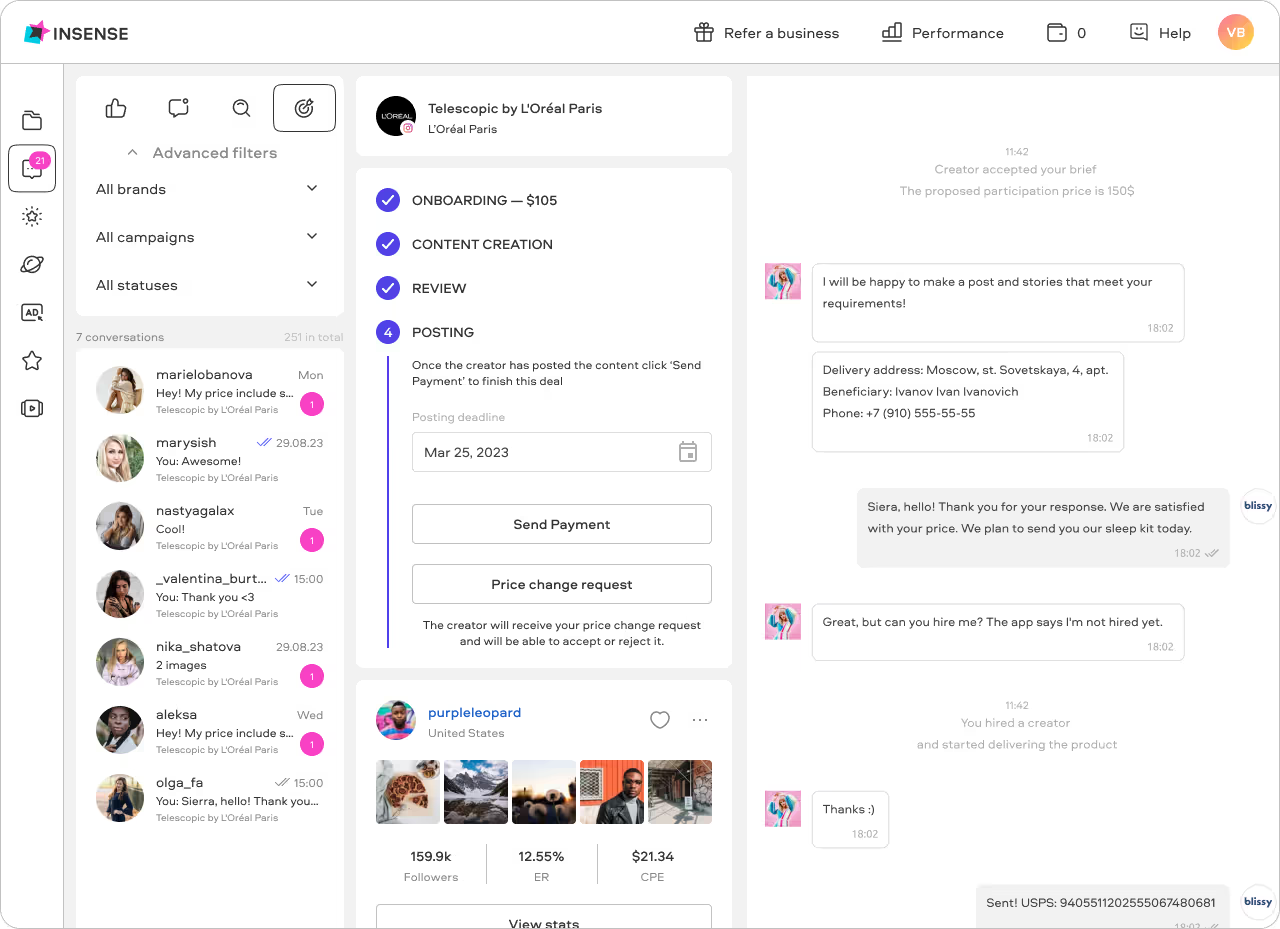You’ve built something great… something worth talking about. Your brand has a clear voice, a point of view, and you have a hunch that influencer marketing could be a real growth lever.
But finding the right influencers is tougher than it looks.
Sure, you could scroll through hashtags or send a bunch of cold DMs. Maybe that worked a few years ago. But today, it’s inefficient at best, and a black hole for your time at worst.
That’s where influencer discovery tools come into play.
The best platforms don’t just toss you a giant list of creators, they let you filter by what actually matters, like niche, engagement rate, audience quality, even whether someone’s eligible for TikTok Shop.
In this guide, we’ll walk you through 12 of the most useful influencer search tools on the market in 2025, including what they do best, who they’re ideal for, and how they work under the hood.
What are Influencer Search Tools?
Influencer search tools help brands find the right creators faster.
Unlike basic influencer databases that simply list profiles, discovery tools let you filter by audience, niche, engagement rate, platform, and more, so you’re not sifting through hundreds of irrelevant options.
They save time, surface high-quality matches, and make targeted outreach a breeze. Instead of guessing who might be a fit, you can find creators who actually align with your goals and are ready to collaborate.
Quick Comparison: Best Influencer Search and Discovery Tools

Detailed Reviews of the Best Influencer Search Tools
Here are our pick of the best influencer search tools on the market right now.
1. Insense
Best for: All-in-one influencer search, collaboration, and UGC campaigns
Insense is a complete creator marketing solution, designed for brands and agencies that want to scale content production without getting bogged down in the details.

You can create influencer or UGC campaigns based on your goals and browse a global marketplace of over 68,500 vetted influencers, but there’s also a creator outreach tool with more than 7 million influencers.

The platform lets you narrow down content creators by country, audience demographics, engagement rate, or even TikTok Shop and Amazon Storefront eligibility. Plus, the built-in creator chat makes it easy to collaborate, give feedback, and manage deliverables all in one place.

If you need content fast, the managed services give you access to Insense’s in-house strategists, editors, and account managers who handle everything from creative research to post-production.
Meanwhile, the content library keeps your raw assets, final edits, and usage rights organized and accessible for your team. You’ll also get performance tracking dashboards to help you understand what’s working and scale accordingly.
Pricing
Insense offers three main plans: a Brand Plan for individual brands (includes 2 user seats and 5 whitelisting licenses), an Agency Plan (supports up to 4 brands with unlimited whitelisting), and a Trial Plan for one-month testing.
All plans include access to the creator marketplace, campaign setup tools, and the wallet-based payment system, so you only pay for approved content. Pricing is tailored to your needs, with managed services available via custom proposals.
Pros:
- Combines influencer discovery, campaign management, and content production in one place
- Access to global creators with filters for engagement, niche, and storefront eligibility
- Offers both self-serve and managed services for flexible scaling
- Built-in messaging, contracts, payments, and performance analytics
- Full content usage rights included via the brief
Cons:
- Trial plan offers limited features
- May require onboarding time to explore all available tools
User ratings: 4.4 stars on G2.
2. Heepsy
Best for: Fast & precise micro-influencer discovery
Heepsy gives users access to over 11 million influencers across Instagram, YouTube, TikTok, and Twitch, with filters that include audience demographics, engagement rates, location, language, niche, and even fake follower detection.
If your priority is finding the right influencers quickly, Heepsy’s no-frills interface and lightning-fast search make that process efficient from the start.
The platform also provides performance metrics like estimated cost per post, audience authenticity scores, and follower growth trends to help you avoid costly mistakes.
You can organize influencers into lists, export them for campaign planning, and track outreach efforts directly from the platform. While Heepsy doesn’t offer campaign management or UGC features, it’s a strong tool for marketers focused solely on precision discovery.
Pricing
Heepsy offers four pricing tiers: Free, Starter, Plus, and Advanced.
The Free plan lets you explore basic search functions with limited results.
Starter plans begin around $89/month and increase with access to advanced filters, influencer contact info, and export options.
The Plus ($249 a month) and Advanced ($369 a month) plans offer more detailed analytics and team collaboration tools. It's a scalable pricing model that makes it easy to test the tool before committing.
Pros:
- Fast and accurate TikTok and Instagram influencer search across multiple platforms
- Detailed filters including engagement, audience authenticity, and niche tags
- Fake follower detection and real-time follower metrics
- Easy-to-use, beginner-friendly interface
- Export and list management for organized outreach
Cons:
- Doesn’t include UGC tools or campaign management features
- No direct messaging or in-platform creator collaboration
- Limited value if you’re already past the discovery phase
User ratings: 4.5 stars on G2.
3. HypeAuditor
Best for: Deep analytics and influencer authenticity checks
HypeAuditor’s AI-powered reports break down everything from audience quality and fake follower scores to follower location, brand affinity, audience overlap, and even suspicious growth spikes.
You’ll also find tools for campaign tracking, competitor benchmarking, and influencer discovery across Instagram, YouTube, TikTok, and Twitch.
A standout feature is its “Audience Credibility Score,” which evaluates how trustworthy an influencer’s followers really are. While the UI can be a little more technical, the trade-off is rich data that supports more strategic, insight-led campaigns.
Pricing
HypeAuditor offers custom pricing based on features and usage levels, which makes it better suited for teams with larger budgets or enterprise needs.
It doesn’t publish standard pricing tiers, but plans generally start around $399/month and scale depending on the number of reports, platform access, and collaboration tools.
There’s a free trial option so you can test the platform’s analytics before committing.
Pros:
- Market-leading influencer analytics with deep audience insights
- Tools to detect fake followers, bots, and suspicious activity
- Strong for campaign tracking, competitive research, and reporting
- Multi-platform support with advanced filtering
- Great for brands prioritizing trust, quality, and measurable ROI
Cons:
- Steeper learning curve than simpler search tools
- Pricing may be too high for smaller brands or startups
- Not built for creator collaboration or UGC production
User ratings: 4.6 stars on G2.
4. Meltwater (formerly Klear)
Best for: AI-driven influencer search with minimal setup
Meltwater’s standout feature is its AI-powered search engine, which analyzes over 30 million influencer profiles across Instagram, YouTube, TikTok, and Twitter.
You can filter by niche, audience demographics, location, and even past brand collaborations to find the perfect match.
Beyond search, Meltwater offers solid influencer CRM capabilities.
You can manage campaigns, handle contracts, track content deliverables, and measure ROI all within the platform.
Pricing
Meltwater doesn’t list pricing publicly and instead offers tailored plans based on your business size and feature needs.
A free demo is available on request, which gives you a hands-on look at its discovery and management features.
Pros:
- Powerful AI-driven search for faster, smarter influencer matching
- Influencer CRM tools to manage contracts, comms, and content
- Streamlined UI makes onboarding easy
- Includes fraud detection and audience quality metrics
- Ideal for multi-region or multi-language campaigns
Cons:
- Higher pricing tier may be a barrier for smaller teams
- Less UGC-focused—more geared toward influencer collaborations than content creation
- AI recommendations can sometimes skew toward larger creators
User ratings: 4.3 stars on Capterra.
5. Collabstr
Best for: Quick influencer partnerships on a free marketplace
Collabstr connects brands with pre-vetted influencers who list their services. You can browse by platform (Instagram, TikTok, YouTube, and UGC creators), apply filters like niche, country, or pricing, and book a creator in just a few clicks.
Beyond search and booking, the platform facilitates communication, payments, and deliverables. Collabstr holds funds in escrow until work is completed, which gives an added layer of trust for both sides.
While it doesn’t offer advanced features like analytics dashboards or creator performance metrics, it’s a good choice for brands that want one-off collaborations or are just getting started with influencer marketing.
Pricing
It’s free to browse the marketplace and search for creators.
You only pay when you hire someone, and creator rates are listed transparently on their profiles, typically ranging from $50 to $500+ depending on the platform, content type, and creator size.
If you want more features, like live analytics and advanced features, you’ll need a Pro ($299 a month) or a Premium ($399 a month) account.
Pros:
- Transparent pricing and fast booking—great for small teams
- No subscriptions or hidden fees
- Built-in payment protection with escrow
- Easy access to both influencers and UGC creators
- Ideal for one-off campaigns or content testing
Cons:
- No built-in analytics or performance tracking
- Less control over vetting because the research is up to you
- Not built for long-term collaboration or campaign scaling
User ratings: 4.8 stars on Trustpilot.
6. NinjaOutreach
Best for: Automating influencer research & outreach
Unlike most creator marketplaces, NinjaOutreach focuses on automating outreach, with a database of millions of influencers across Instagram, YouTube, blogs, and X.
You can search by keyword, niche, location, or engagement metrics, then build prospect lists and launch personalized outreach campaigns directly from the platform.
The built-in CRM lets you track replies, follow-ups, and campaign statuses in one place, and the email automation features are especially handy for agencies managing dozens of potential partners.
While it doesn’t include creator content delivery or UGC production tools, NinjaOutreach fills a unique niche for teams that want to streamline the influencer search, pitch, and reply pipeline.
Pricing
NinjaOutreach starts at $389/month for the Flex plan, which includes access to the influencer database, email outreach tools, and CRM features.
Higher-tier plans unlock more users, more outreach volume, and dedicated onboarding support. It’s not the cheapest tool on this list, but it’s priced for marketers who are serious about scaling influencer discovery and outreach like a sales pipeline.
Pros:
- Powerful search with built-in outreach automation
- Huge database of creators, bloggers, and social media influencers
- CRM-style tracking for influencer pipeline management
- Great for cold outreach and backlink campaigns too
- Helps you scale faster without dozens of manual DMs
Cons:
- No creator content tools or UGC workflows
- More suited for outreach than collaboration
- Pricing may be too high for small brands or one-off campaigns
User ratings: 4 stars on G2.
7. BuzzSumo
Best for: Combining influencer discovery with content marketing
BuzzSumo is more of a content intelligence platform that helps you discover what’s trending in your industry and who’s driving those conversations.
Instead of starting with a creator database, you start with top-performing content. Search a keyword or topic, and BuzzSumo shows you who’s sharing, creating, or amplifying that content.
This reverse discovery model is ideal for brands that want thought leaders, niche influencers, or high-authority creators tied to specific topics.
It’s especially powerful when paired with BuzzSumo’s content research tools, which lets you monitor competitors, set up alerts, and track backlinks. While it’s not built for Instagram or TikTok-style UGC campaigns, it shines for B2B, editorial, and SEO-driven influencer programs.
Pricing
BuzzSumo offers several plans, starting with the Content Creation plan, which is $199 a month. For more features, including more users and searches, you’ll need the PR & Comms plan ($299 a month), Suite plan ($499 a month), or the Enterprise plan ($999 a month).
Pros:
- Content-first approach helps find real topic experts, not just influencers
- Powerful keyword tracking, alerts, and backlink data
- Ideal for B2B, thought leadership, and blog-focused campaigns
- Strong content marketing and PR integrations
- Great for competitor research and trend spotting
Cons:
- Not focused on visual platforms like TikTok or Instagram
- No direct messaging or campaign management tools
- Less suited for DTC or product seeding campaigns
User ratings: 4.5 stars on G2.
8. Modash
Best for: Comprehensive influencer filtering and global database
With over 200 million creators in its database across Instagram, TikTok, and YouTube, Modash is one of the most expansive influencer discovery tools available. What sets it apart is how specific you can get. You can filter by audience location, engagement rate, language, gender, brand mentions, and even follower credibility. If you’re running campaigns across multiple countries or verticals, that level of precision is a huge win.
The platform also includes influencer profile previews, email addresses (when available), fake follower detection, and audience overlap tools to avoid saturation.
While Modash doesn’t offer built-in messaging or content collaboration features, it makes influencer prospecting much faster and more strategic. For brands managing influencer lists, Modash also offers export options and campaign tracking features to help keep everything organized.
Pricing
Modash offers transparent pricing with three main plans: Essentials ($199 a month), Performance ($499 a month), and Custom Enterprise options.
Each tier offers a different number of influencer profile views, export limits, and API access. All plans include access to the full database and search filters, making it easy to scale up as your campaigns grow. A 14-day free trial is also available.
Pros:
- One of the largest creator databases with global coverage
- Advanced filtering for audience data, language, and brand affinity
- Audience credibility tools to weed out fake followers
- Exportable lists and easy-to-navigate UI
- Great for agencies and cross-border campaigns
Cons:
- No direct messaging or content collaboration tools
- More of a search engine than a campaign management platform
- Not focused on UGC production or post-creation analytics
User ratings: 4.9 stars on G2.
9. Later
Best for: Instagram influencer discovery for small businesses
Originally built as a social media scheduling tool, Later has steadily expanded into influencer marketing with its Influencer Search feature.
Unlike platforms that prioritize massive databases, Later focuses on helping brands find authentic creators who align with their niche and visual aesthetic. You can search by handle, keyword, follower count, or engagement rate, and the tool provides influencer profiles with audience metrics and sample content.
While the discovery capabilities are more limited than heavy-duty platforms like Modash or HypeAuditor, Later shines for its ease of use, beautiful UI, and focus on visual storytelling through creators.
Pricing
Influencer discovery is included with Later’s Influence and is priced on a custom basis depending on your unique needs.
Pros:
- Simple, visual-first interface great for Instagram discovery
- Integrated with scheduling, analytics, and link-in-bio tools
- Affordable entry-level pricing for small brands
- Ideal for finding lifestyle and niche creators
- Easy to use for non-technical teams
Cons:
- Limited influencer database compared to larger platforms
- Currently focused on Instagram (less support for TikTok or YouTube)
- No direct messaging or full campaign management features
User ratings: 4.5 stars on G2.
10. Pitchbox
Best for: Blog-focused influencer research and SEO
Pitchbox is a little bit different because it’s built specifically for SEO-driven outreach and digital PR.
Instead of focusing on social media influencers, Pitchbox helps brands and agencies connect with bloggers, publishers, and thought leaders who can drive backlinks, organic visibility, and domain authority. You just enter a keyword or niche, and Pitchbox finds relevant blogs, contact info, and even drafts personalized outreach emails at scale.
It also integrates with tools like Moz, Ahrefs, SEMrush, and Majestic to find high-authority prospects based on domain metrics. You can manage follow-ups, track campaign status, and measure reply rates all from one dashboard.
Pricing
Pitchbox has three plans, Pro ($165 a month), Advanced ($420 a month), and Scale ($675 a month).
Pros:
- Purpose-built for SEO, blogger outreach, and backlink generation
- Deep integrations with leading SEO tools (Ahrefs, SEMrush, etc.)
- Automated, personalized outreach sequences
- Strong campaign tracking and pipeline visibility
- Ideal for B2B and content-driven brands
Cons:
- Not intended for social media influencer or UGC campaigns
- High starting price point
- Steeper learning curve for non-technical users
User ratings: 4.7 stars on G2.
11. Traackr
Best for: Global influencer discovery & management for enterprises
Traackr offers a powerful discovery engine with in-depth filters for location, audience demographics, niche, language, content type, and past collaborations. But where it really shines is in its Influencer Relationship Management (IRM) system, which lets teams manage everything from influencer contracts and content calendars to campaign performance and ROI in one place.
Traackr also supports always-on influencer strategies with detailed performance benchmarks, spend tracking, and “brand safety” signals to flag risky creators.
Pricing
Traackr is an enterprise platform and its prices reflect that. The Standard plan is $32,500 a year, while the Plus plan is $55,000 a year.
Pros:
- Comprehensive IRM and campaign reporting tools
- Built for global teams, with multi-market visibility and compliance tools
- Spend tracking and ROI analysis built-in
- Highly customizable with workflow automation
- Trusted by major brands in beauty, fashion, tech, and pharma
Cons:
- High cost and designed for large or enterprise teams only
- Requires onboarding and setup time
- Less relevant for small businesses or one-off campaigns
User ratings: 4.3 stars on G2.
12. #paid
Best for: Fast influencer collaborations via marketplace
Unlike traditional search tools where brands have to dig through databases, #paid does things a bit differently. Creators apply to your campaign based on your brief. This opt-in model means you're connecting with people who already want to work with your brand.
You can launch a campaign, review creator applications, approve content, and run whitelisted ads, all from one place.
The platform also streamlines content licensing, usage rights, and ad integration with Meta (Facebook/Instagram), so you can easily turn creator content into high-performing paid ads.
Pricing
#paid offers a Starter Plan starting at around $499/month, which includes access to the creator network, campaign setup tools, and content review workflows.
Higher-tier plans include enhanced analytics, creator performance history, and advanced ad integrations. Brands also pay creators per campaign, which varies based on content type and deliverables. Custom enterprise pricing is available for high-volume users.
Pros:
- Creators apply to your campaign, so no cold outreach required
- Ideal for scaling UGC and whitelisted ads quickly
- Easy campaign setup and creator communication
- Strong Meta integration for running influencer ads
- Great mix of influencers and content-only creators
Cons:
- Monthly platform fee may be high for smaller brands
- Limited search functionality and reliant on creator opt-in
- Not built for influencer relationship management or outreach
User ratings: 4.7 stars on G2.
How to Choose the Best Influencer Discovery Tool
With so many influencer platforms out there, it’s easy to get stuck comparing tabs instead of running campaigns. The key is knowing which features actually move the needle.
Here’s what to look for when choosing the right influencer discovery tool for your brand.
Influencer database size
Start with reach. A strong platform should give you access to thousands (ideally tens of thousands, if not millions) of creators across multiple verticals and regions. The more options you have, the better your chances of finding the right fit based on your campaign goals.
Advanced influencer search filters
Look for tools that let you filter by:
- Audience demographics (age, gender, location)
- Keywords or niche categories
- Engagement rate
- Platform activity
- Amazon Storefronts or TikTok Shop affiliation
Influencer vetting and authenticity
Numbers only tell part of the story. A good discovery tool should help you dig into:
- Real engagement vs. bot followers
- Past content performance
- Brand safety and tone alignment
- Content quality and style
Pricing and free trial availability
Some tools lock everything behind a paywall, while others give you a free trial to explore what’s possible. Look for transparent pricing and flexible plans that fit your campaign needs, especially if you're testing a new strategy or scaling up quickly.
User experience
You don’t want to spend more time trying to figure out how to use the platform than you do creating campaigns. Regardless of how powerful a platform is, it should still be easy to use.
Prioritize tools with:
- Clean, intuitive dashboards
- Easy onboarding and walkthroughs
- Strong creator communication tools (like built-in chat)
- Integration options that work with your ad stack or content workflow
Frequently Asked Questions (FAQs)
What is influencer discovery, and why is it important?
Influencer discovery is the process of finding creators who align with your brand and audience. It’s important because working with the right creators leads to better content, stronger results, and less wasted time.
How do influencer search tools differ from influencer databases?
Influencer databases are often static lists with basic profile info, while search tools are dynamic platforms that let you filter by audience data, engagement, niche, and more, so you can actually find creators who fit your campaign goals.
Are influencer search tools worth it for small businesses or DTC brands?
Yes, especially if you want to save time, find quality creators, and scale without hiring a full influencer team. Many platforms offer affordable plans or pay-as-you-go options, making them accessible even if you’re just starting out.
How do influencer discovery tools detect fake followers?
Most tools use data points like follower growth trends, engagement quality, audience authenticity scores, and bot detection algorithms to flag suspicious accounts, so you can avoid creators with inflated or low-quality followings.
Can I find Instagram influencers specifically with these tools?
Absolutely. Nearly all top influencer search platforms include Instagram support, with filters for follower count, niche, engagement rate, location, and more, making it easy to find creators who match your brand’s style and goals.
Do influencer finder tools help with influencer outreach and campaign management?
Some do, yes. Platforms like Insense offer built-in messaging, brief creation, contract tools, and content approvals, so you can go from search to collaboration to campaign delivery without switching platforms. Others focus only on search.







.avif)


